
|
It will approach to Sun down to 0.4 a.u. in late September, and it is expected to brighten up to 2 mag. The brightness evolution slowed down since May. But it brightened up to 8.2 mag in mid August (Aug. 12, Thomas Lehmann). The comet is bright as 7.2 mag on Aug. 17 in the STEREO spacecraft image (Toni Scarmato). It brightens up to 2 mag, but it will turn to fade out rapidly after that. Now it is not observable. It will appear soon in the Southern Hemisphere, or in October in the Northern Hemisphere.
Date(TT) R.A. (2000) Decl. Delta r Elong. m1 Best Time(A, h)
Aug. 31 10 43.72 -3 8.6 1.761 0.801 11 6.5 19:04 ( 79,-10)
Sept. 7 10 40.20 -4 9.8 1.619 0.665 11 5.7 4:47 (281, -8)
|

|
It returned for the first time in 68 years. It brightened up to 6.2 mag in early summer (July 1, Virgilio Gonano). Now it is 7.5 mag (Aug. 25, Virgilio Gonano). It will fade out rapidly after this. It will be unobservable in October in the Southern Hemisphere, or in November in the Northern Hemisphere.
Date(TT) R.A. (2000) Decl. Delta r Elong. m1 Best Time(A, h)
Aug. 31 13 14.99 19 21.7 2.129 1.496 39 8.5 19:04 (119, 7)
Sept. 7 13 36.57 15 45.3 2.210 1.559 38 8.8 19:09 (114, 7)
|

|
It returns for the first time in 70 years. It brightened up to 3.7 mag in early April (Apr. 6, Jose Guilherme Aguiar). Now it is 10.0 mag (Aug. 21, Taras Prystavski). Fading gradually. In the Northern Hemisphere, it is not observable now. It locates somewhat low in the Southern Hemisphere. But it will become high in winter.
Date(TT) R.A. (2000) Decl. Delta r Elong. m1 Best Time(A, h)
Aug. 31 12 17.35 -47 22.7 2.587 2.262 60 10.5 19:04 ( 51, 31)
Sept. 7 12 39.83 -47 29.1 2.728 2.349 57 10.8 19:09 ( 50, 29)
|
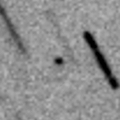
|
It will fade out rapidly after this. In the Northern Hemisphere, it is not observable now, but it will be observable soon. It stays extremely low in the Southern Hemisphere.
Date(TT) R.A. (2000) Decl. Delta r Elong. m1 Best Time(A, h)
Aug. 31 11 46.88 3 16.4 1.875 0.967 18 11.7 19:04 ( 93, -1)
Sept. 7 12 20.06 2 29.6 1.909 1.017 19 12.0 19:09 ( 93, 0)
|
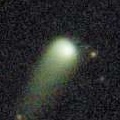
|
Now it is 12.5 mag (Aug. 7, Osamu Miyazaki). It stays 12 mag for a while. In the Northern Hemisphere, it stays observable in good condition. In the Southern Hemisphere, it is not observable now.
Date(TT) R.A. (2000) Decl. Delta r Elong. m1 Best Time(A, h)
Aug. 31 7 34.68 43 57.3 4.186 3.668 53 12.4 4:56 (219, -6)
Sept. 7 7 36.45 45 14.4 4.077 3.667 59 12.3 4:47 (216, -5)
|

|
Now it is 12.7 mag (Aug. 7, Thomas Lehmann). It stays 13 mag for a while. It stays extremely low in the Northern Hemisphere. But it will become high in spring. In the Southern Hemisphere, it will be getting lower gradually after this, and it will be unobservable in December.
Date(TT) R.A. (2000) Decl. Delta r Elong. m1 Best Time(A, h)
Aug. 31 16 30.59 -48 8.2 2.220 2.521 95 12.7 19:04 ( 40, 71)
Sept. 7 16 42.51 -45 40.6 2.270 2.496 90 12.8 19:09 ( 52, 70)
|
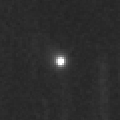
|
Now it is 14.9 mag (Aug. 24, ATLAS Chile). Fading slowly. It stays extremely low in the Northern Hemisphere. In the Southern Hemisphere, it stays observable in good condition.
Date(TT) R.A. (2000) Decl. Delta r Elong. m1 Best Time(A, h)
Aug. 31 14 46.97 -23 20.3 1.742 1.668 68 14.0 19:04 ( 95, 50)
Sept. 7 15 5.84 -24 4.1 1.775 1.653 66 13.9 19:09 ( 92, 48)
|

|
It brightened very rapidly up to 10.0 mag in June (June 11, Virgilio Gonano). Now it is 13.8 mag (Aug. 23, Ken-ichi Kadota). Fading rapidly. It will be fainter than 18 mag in November. It will be unobservable in October in the Southern Hemisphere, or in November in the Northern Hemisphere.
Date(TT) R.A. (2000) Decl. Delta r Elong. m1 Best Time(A, h)
Aug. 31 13 41.35 26 58.4 2.346 1.816 47 13.9 19:04 (129, 6)
Sept. 7 13 56.73 23 16.3 2.465 1.894 45 14.3 19:09 (123, 6)
|
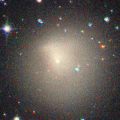
|
In the Northern Hemisphere, it will be getting higher gradually. In the Southern Hemisphere, it is not observable now, but it will be observable soon.
Date(TT) R.A. (2000) Decl. Delta r Elong. m1 Best Time(A, h)
Aug. 31 9 28.13 14 14.9 7.180 6.227 17 14.2 4:56 (258, -7)
Sept. 7 9 32.98 13 47.2 7.141 6.229 23 14.2 4:47 (256, -4)
|

|
Now it is 14.5 mag (Aug. 16, ATLAS South Africa). It stays 14 mag for a while. In the Northern Hemisphere, it is not observable now, but it will appear in November. In the Southern Hemisphere, it will be unobservable in October. But it will be observable again in December.
Date(TT) R.A. (2000) Decl. Delta r Elong. m1 Best Time(A, h)
Aug. 31 12 58.58 -18 56.0 5.654 4.983 44 14.2 19:04 ( 84, 26)
Sept. 7 13 5.42 -18 51.6 5.723 4.982 39 14.3 19:09 ( 81, 21)
|

|
Now it is 13.9 mag (Aug. 3, Ken-ichi Kadota). Fading gradually. In the Northern Hemisphere, it stays observable in good condition. It stays extremely low in the Southern Hemisphere.
Date(TT) R.A. (2000) Decl. Delta r Elong. m1 Best Time(A, h)
Aug. 31 7 18.37 36 30.8 2.199 1.783 52 14.3 4:56 (222, 1)
Sept. 7 7 37.57 36 11.3 2.188 1.821 55 14.7 4:47 (222, 2)
|
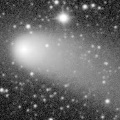
|
It brightened up to 9.6 mag from February to March (Feb. 25, Thomas Lehmann). Now it is 13.3 mag (Aug. 26, Osamu Miyazaki). Fading gradually. In the Northern Hemisphere, it stays observable in good condition. In the Southern Hemisphere, it will be unobservable in November.
Date(TT) R.A. (2000) Decl. Delta r Elong. m1 Best Time(A, h)
Aug. 31 19 19.95 54 39.8 2.562 2.979 104 14.3 20:39 (180, 0)
Sept. 7 19 21.12 52 47.4 2.634 3.052 104 14.4 20:13 (180, 2)
|

|
It is expected to brighten up to 13 mag in 2025 autumn, and it will be observable in good condition. Now it is 14.9 mag (Aug. 15, Taras Prystavski). It stays 15 mag for a while. It stays observable in good condition.
Date(TT) R.A. (2000) Decl. Delta r Elong. m1 Best Time(A, h)
Aug. 31 22 52.39 -4 21.7 3.787 4.793 174 14.7 0:16 (180, 59)
Sept. 7 22 49.43 -4 33.4 3.752 4.758 176 14.6 23:41 (180, 59)
|
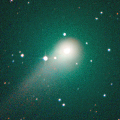
|
It was observed at 9-10 mag for a long time in 2023. Now it is 14.9 mag (Aug. 14, ATLAS Chile). Fading slowly. In the Northern Hemisphere, it will never be observable after this. In the Southern Hemisphere, it stays observable in good condition.
Date(TT) R.A. (2000) Decl. Delta r Elong. m1 Best Time(A, h)
Aug. 31 22 54.41 -70 16.1 4.845 5.398 118 14.7 0:19 ( 0, 55)
Sept. 7 22 34.07 -70 42.6 4.948 5.454 115 14.8 23:25 ( 0, 54)
|
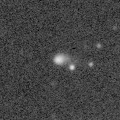
|
Now it is 15.6 mag (Aug. 18, ATLAS-HKO, Haleakala). It stays 15 mag for a while. It stays observable in good condition.
Date(TT) R.A. (2000) Decl. Delta r Elong. m1 Best Time(A, h)
Aug. 31 6 27.09 3 24.0 6.526 6.125 62 15.1 4:56 (236, 34)
Sept. 7 6 30.94 3 21.0 6.411 6.102 67 15.0 4:47 (233, 36)
|

|
Now it is 14.2 mag (Aug. 17, Hiroshi Abe). Fading gradually. It stays observable in good condition.
Date(TT) R.A. (2000) Decl. Delta r Elong. m1 Best Time(A, h)
Aug. 31 2 41.55 8 15.2 1.503 2.157 116 15.1 4:04 (180, 47)
Sept. 7 2 42.93 8 18.0 1.465 2.187 123 15.1 3:38 (180, 47)
|

|
Now it is 14.5 mag (Aug. 20, Ken-ichi Kadota). It will fade out rapidly after this. It will be fainter than 18 mag in December. In the Northern Hemisphere, it stays observable in good condition.
Date(TT) R.A. (2000) Decl. Delta r Elong. m1 Best Time(A, h)
Aug. 31 5 1.51 11 21.0 1.181 1.450 82 15.1 4:56 (208, 39)
Sept. 7 5 16.47 13 36.5 1.154 1.469 85 15.3 4:47 (206, 37)
|
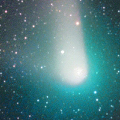
|
It brightened up to 8 mag from 2022 summer to 2023 spring. Now it is 14.9 mag (Aug. 10, Ken-ichi Kadota). It stays 16 mag for a while. In the Northern Hemisphere, it stays observable in good condition.
Date(TT) R.A. (2000) Decl. Delta r Elong. m1 Best Time(A, h)
Aug. 31 6 23.73 17 19.0 7.077 6.667 62 15.4 4:56 (225, 24)
Sept. 7 6 25.18 17 29.1 7.025 6.723 68 15.4 4:47 (221, 26)
|
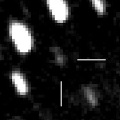
|
The condition is bad in this apparition. It must have brightened up to 10 mag in early summer, however, it is not observable at all. Fading rapidly. It will be fainter than 18 mag in October. It will never be observable after this.
Date(TT) R.A. (2000) Decl. Delta r Elong. m1 Best Time(A, h)
Aug. 31 11 4.76 13 48.7 2.668 1.676 8 15.4 19:04 ( 96,-15)
Sept. 7 11 22.17 12 8.7 2.729 1.736 7 15.9 19:09 ( 92,-18)
|
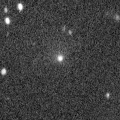
|
Very large comet. It is expected to brighten up to 13 mag in 2031. Now it is 15.9 mag (July 25, Hidetaka Sato). It stays 15 mag for a while. In the Northern Hemisphere, it is not observable now. In the Southern Hemisphere, it stays observable in good condition. In the Northern Hemisphere, it is not observable until 2030.
Date(TT) R.A. (2000) Decl. Delta r Elong. m1 Best Time(A, h)
Aug. 31 4 21.12 -66 26.3 15.807 16.006 99 15.5 4:56 (351, 58)
Sept. 7 4 21.90 -66 56.4 15.783 15.982 99 15.5 4:47 (355, 58)
|

|
Now it is 15.6 mag (July 24, Thomas Lehmann). It stays 16 mag for a while. In the Northern Hemisphere, it is not observable now, but it will appear in October. In the Southern Hemisphere, it will be getting higher gradually.
Date(TT) R.A. (2000) Decl. Delta r Elong. m1 Best Time(A, h)
Aug. 31 9 52.89 -25 3.0 3.992 3.223 35 15.5 4:56 (294, 10)
Sept. 7 9 54.10 -25 50.9 4.023 3.262 36 15.6 4:47 (292, 14)
|
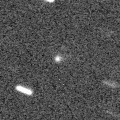
|
Now it is 16.5 mag (Apr. 3, Taras Prystavski). It stays 16 mag for a while. Now it is not observable. It will appear soon in the Northern Hemisphere, or in November in the Southern Hemisphere.
Date(TT) R.A. (2000) Decl. Delta r Elong. m1 Best Time(A, h)
Aug. 31 9 39.92 15 32.2 2.768 1.817 15 15.6 4:56 (258,-10)
Sept. 7 9 58.20 14 18.3 2.754 1.822 17 15.6 4:47 (259, -9)
|

|
It approaches to Sun down to 0.09 a.u. on Jan. 13, 2025. According to the calculation, it will brighten up to -1 mag. But probably, it will be disintegrated. At the high light, it may be observable after the perihelion passage only in the Southern Hemisphere. Now it is 15.8 mag (Aug. 23, Hidetaka Sato). It will brighten rapidly after this. In the Northern Hemisphere, it will never be observable after this. In the Southern Hemisphere, it will be getting lower gradually after this, and it will be unobservable in December.
Date(TT) R.A. (2000) Decl. Delta r Elong. m1 Best Time(A, h)
Aug. 31 13 22.15 -53 35.1 2.968 2.811 71 15.9 19:04 ( 46, 42)
Sept. 7 13 30.28 -52 8.9 2.957 2.710 66 15.7 19:09 ( 47, 38)
|
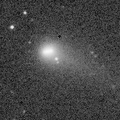
|
It brightened up to 13.5 mag in winter (Dec. 5, Chris Wyatt). Fading slowly. Now it is not observable. It will appear in October in the Northern Hemisphere, or in November in the Southern Hemisphere.
Date(TT) R.A. (2000) Decl. Delta r Elong. m1 Best Time(A, h)
Aug. 31 10 55.45 14 5.3 3.334 2.336 6 15.8 19:04 ( 95,-17)
Sept. 7 11 9.00 12 38.7 3.363 2.365 6 15.9 19:09 ( 91,-21)
|

|
It approached to Sun down to 0.12 a.u. on Aug. 4. Fading rapidly. It will be fainter than 18 mag soon. In the Northern Hemisphere, it will never be observable after this. In the Southern Hemisphere, it stays observable in good condition.
Date(TT) R.A. (2000) Decl. Delta r Elong. m1 Best Time(A, h)
Aug. 31 8 20.11 -17 34.7 0.274 0.830 42 15.9 4:56 (275, 24)
Sept. 7 6 50.40 -45 29.5 0.226 0.979 76 16.2 4:47 (300, 54)
|
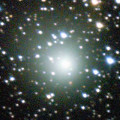
|
It brightened up to 8.3 mag in 2021-2022 winter (Jan. 6, 2022, Toshiyuki Takahashi). Now it is 16.3 mag (July 16, ATLAS Chile). It stays 16 mag for a while. In the Northern Hemisphere, it will never be observable after this. It locates somewhat low in the Southern Hemisphere. But it will become high in autumn.
Date(TT) R.A. (2000) Decl. Delta r Elong. m1 Best Time(A, h)
Aug. 31 11 28.59 -46 39.5 9.108 8.592 56 16.0 19:04 ( 48, 22)
Sept. 7 11 33.67 -46 54.5 9.199 8.636 53 16.0 19:09 ( 45, 19)
|

|
Now it is 16.4 mag (Aug. 20, Ken-ichi Kadota). It stays 16 mag for a while. In the Northern Hemisphere, it stays observable in good condition. In the Southern Hemisphere, it is not observable now.
Date(TT) R.A. (2000) Decl. Delta r Elong. m1 Best Time(A, h)
Aug. 31 5 2.25 52 4.3 2.758 2.757 79 16.1 4:56 (194, 1)
Sept. 7 5 18.00 53 56.0 2.667 2.732 82 16.0 4:47 (193, -1)
|
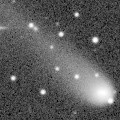
|
Now it is 14.9 mag (June 5, Thomas Lehmann). It stays 17 mag for a while. In the Northern Hemisphere, it is not observable now, but it will be observable soon. In the Southern Hemisphere, it stays observable in good condition.
Date(TT) R.A. (2000) Decl. Delta r Elong. m1 Best Time(A, h)
Aug. 31 7 54.23 -36 31.0 6.208 5.757 59 16.2 4:56 (292, 38)
Sept. 7 7 55.34 -37 26.4 6.211 5.800 61 16.2 4:47 (292, 42)
|

|
Brightened rapidly. Now it is 16.0 mag (Aug. 26, Hirohisa Sato). Fading gradually. It will be fainter than 18 mag in November. It stays observable in good condition.
Date(TT) R.A. (2000) Decl. Delta r Elong. m1 Best Time(A, h)
Aug. 31 22 38.27 -0 42.8 1.360 2.364 172 16.2 0:04 (180, 55)
Sept. 7 22 1.85 -3 37.6 1.372 2.359 164 16.2 22:51 (180, 59)
|

|
It brightened very rapidly in outburst in late May. Now it is 16.3 mag (Aug. 15, ATLAS Chile). Fading slowly. It will be unobservable in November.
Date(TT) R.A. (2000) Decl. Delta r Elong. m1 Best Time(A, h)
Aug. 31 15 55.01 -22 37.6 3.169 3.218 83 16.2 19:04 (110, 63)
Sept. 7 16 2.29 -22 39.9 3.271 3.225 78 16.3 19:09 (104, 59)
|
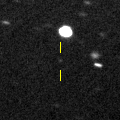
|
Now it is 16.2 mag (Aug. 24, ATLAS-HKO, Haleakala). It stays 16 mag for a while. It stays observable in good condition.
Date(TT) R.A. (2000) Decl. Delta r Elong. m1 Best Time(A, h)
Aug. 31 5 58.80 15 56.0 3.648 3.405 68 16.4 4:56 (220, 28)
Sept. 7 6 6.37 15 34.2 3.563 3.410 73 16.3 4:47 (218, 30)
|

|
First return of a new periodic comet which brightened up to 16 mag in 2012. It is expected to brighten rapidly up to 14.5 mag in autumn. Now it is 18.5 mag (July 25, Hidetaka Sato). Brightening slowly. In the Northern Hemisphere, it stays observable in good condition. In the Southern Hemisphere, it will be getting lower gradually after this, and it will be unobservable in December.
Date(TT) R.A. (2000) Decl. Delta r Elong. m1 Best Time(A, h)
Aug. 31 4 19.21 1 57.1 1.522 1.888 94 16.6 4:56 (199, 52)
Sept. 7 4 27.07 4 0.5 1.433 1.869 98 16.3 4:47 (194, 50)
|

|
It is expected to brighten up to 13.5 mag, and it will be observable in good condition in winter. Now it is 17.1 mag (Aug. 13, ATLAS South Africa). Brightening gradually. In the Northern Hemisphere, it will be getting higher gradually. In the Southern Hemisphere, it stays observable in good condition.
Date(TT) R.A. (2000) Decl. Delta r Elong. m1 Best Time(A, h)
Aug. 31 6 28.85 -29 7.4 2.075 1.987 70 16.6 4:56 (274, 53)
Sept. 7 6 36.00 -28 16.4 1.986 1.944 72 16.4 4:47 (271, 55)
|
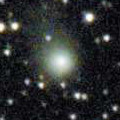
|
It brightened up to 12.1 mag in 2023 spring (May 20, 2023, Jose Guilherme de S. Aguiar). Now it is 16.6 mag (Aug. 11, ATLAS Chile). It stays 17 mag for a while. It stays extremely low in the Northern Hemisphere. In the Southern Hemisphere, it stays observable in good condition.
Date(TT) R.A. (2000) Decl. Delta r Elong. m1 Best Time(A, h)
Aug. 31 6 55.11 -36 26.8 5.661 5.381 68 16.4 4:56 (287, 50)
Sept. 7 6 57.57 -36 51.0 5.665 5.429 71 16.4 4:47 (287, 53)
|
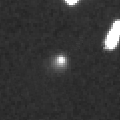
|
Now it is 16.6 mag (Aug. 2, ATLAS South Africa). It stays 16 mag for a while. It locates somewhat low in the Northern Hemisphere. In the Southern Hemisphere, it stays observable in good condition.
Date(TT) R.A. (2000) Decl. Delta r Elong. m1 Best Time(A, h)
Aug. 31 6 49.21 -25 15.1 7.360 6.995 65 16.5 4:56 (271, 47)
Sept. 7 6 53.19 -25 38.1 7.287 6.979 68 16.5 4:47 (269, 50)
|
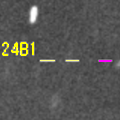
|
Now it is 16.3 mag (Aug. 14, Hidetaka Sato). It stays 17 mag for a while. It locates somewhat low in the Northern Hemisphere. But it will become high in winter. In the Southern Hemisphere, it will never be observable after this.
Date(TT) R.A. (2000) Decl. Delta r Elong. m1 Best Time(A, h)
Aug. 31 8 52.25 46 59.3 2.279 1.710 44 16.6 4:56 (225,-19)
Sept. 7 9 25.73 48 24.1 2.201 1.685 47 16.5 4:47 (225,-21)
|

|
Now it is 16.0 mag (Aug. 25, ATLAS Chile). Fading gradually. It will be fainter than 18 mag in November. It stays observable in good condition.
Date(TT) R.A. (2000) Decl. Delta r Elong. m1 Best Time(A, h)
Aug. 31 23 42.87 -20 24.0 1.519 2.493 160 16.5 1:07 (180, 75)
Sept. 7 23 37.01 -20 36.1 1.533 2.515 163 16.6 0:33 (180, 75)
|
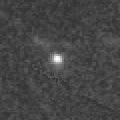
|
Now it is 17.5 mag (Mar. 9, Toshihiko Ikemura, Hirohisa Sato). Brightening slowly. In the Northern Hemisphere, it stays observable in good condition. It stays extremely low in the Southern Hemisphere. But it will become high in winter.
Date(TT) R.A. (2000) Decl. Delta r Elong. m1 Best Time(A, h)
Aug. 31 7 24.57 27 26.3 3.373 2.819 49 16.6 4:56 (229, 7)
Sept. 7 7 36.26 26 59.2 3.288 2.805 53 16.5 4:47 (229, 8)
|

|
Now it is 16.8 mag (Aug. 14, ATLAS Chile). It stays 17 mag for a while. In the Northern Hemisphere, it is not observable now, but it will appear in December. It locates somewhat low in the Southern Hemisphere. But it will become high in winter.
Date(TT) R.A. (2000) Decl. Delta r Elong. m1 Best Time(A, h)
Aug. 31 13 23.60 -39 59.2 5.722 5.322 61 16.5 19:04 ( 64, 39)
Sept. 7 13 24.28 -39 40.1 5.806 5.311 56 16.6 19:09 ( 62, 34)
|

|
Now it is 17.0 mag (Aug. 13, ATLAS-MLO, Mauna Loa). It will fade out rapidly after this. It will be fainter than 18 mag in October. In the Northern Hemisphere, it stays observable in good condition. It stays extremely low in the Southern Hemisphere.
Date(TT) R.A. (2000) Decl. Delta r Elong. m1 Best Time(A, h)
Aug. 31 6 15.41 28 37.6 2.089 1.888 64 16.6 4:56 (216, 16)
Sept. 7 6 28.92 29 51.3 2.069 1.939 68 16.8 4:47 (215, 15)
|

|
Now it is 17.3 mag (May 6, ATLAS Chile). Brightening slowly. In the Northern Hemisphere, it is not observable now, but it will be observable soon. In the Southern Hemisphere, it stays observable in good condition.
Date(TT) R.A. (2000) Decl. Delta r Elong. m1 Best Time(A, h)
Aug. 31 7 55.59 -25 56.2 5.140 4.595 52 16.7 4:56 (280, 34)
Sept. 7 7 59.99 -25 53.8 5.071 4.564 54 16.6 4:47 (278, 37)
|
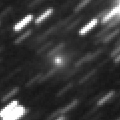
|
Very far object. Now it is 17.1 mag (Aug. 10, ATLAS Chile). It stays 17 mag for a while. In the Northern Hemisphere, it is not observable now. In the Southern Hemisphere, it stays observable in good condition.
Date(TT) R.A. (2000) Decl. Delta r Elong. m1 Best Time(A, h)
Aug. 31 2 46.42 -68 12.6 10.070 10.429 108 16.7 4:09 ( 0, 57)
Sept. 7 2 40.34 -68 38.7 10.078 10.434 108 16.7 3:35 ( 0, 56)
|
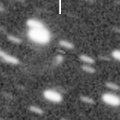
|
Now it is 16.7 mag (Aug. 27, S. Shurpakov). It stays 17 mag for a while. In the Northern Hemisphere, it stays observable in good condition. In the Southern Hemisphere, it will be unobservable in November.
Date(TT) R.A. (2000) Decl. Delta r Elong. m1 Best Time(A, h)
Aug. 31 19 44.84 41 8.3 3.863 4.405 116 16.7 21:04 (180, 14)
Sept. 7 19 34.82 39 1.3 3.914 4.422 114 16.7 20:26 (180, 16)
|
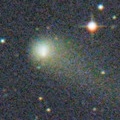
|
It brightened up to 11.1 mag in early 2022 (Mar. 31, 2022, F. Kugel, J.-G. Bosch, J. Nicolas). Now it is 16.4 mag (Aug. 10, ATLAS-MLO, Mauna Loa). It stays 17 mag for a while. In the Northern Hemisphere, it stays observable in good condition. In the Southern Hemisphere, it will be unobservable in November.
Date(TT) R.A. (2000) Decl. Delta r Elong. m1 Best Time(A, h)
Aug. 31 17 13.28 29 26.7 7.498 7.624 93 16.8 19:04 (173, 25)
Sept. 7 17 14.40 28 51.7 7.607 7.665 89 16.9 19:09 (165, 25)
|

|
Now it is 17.8 mag (Aug. 16, ATLAS-MLO, Mauna Loa). It stays 17 mag for a while. It stays observable in good condition.
Date(TT) R.A. (2000) Decl. Delta r Elong. m1 Best Time(A, h)
Aug. 31 0 58.11 1 24.1 1.164 2.065 143 17.1 2:21 (180, 53)
Sept. 7 0 58.28 0 50.5 1.118 2.055 150 16.9 1:54 (180, 54)
|
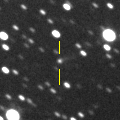
|
It stays 17 mag for a while. It will be getting higher gradually.
Date(TT) R.A. (2000) Decl. Delta r Elong. m1 Best Time(A, h)
Aug. 31 7 33.44 15 4.6 5.488 4.834 45 17.0 4:56 (240, 14)
Sept. 7 7 39.23 14 17.7 5.412 4.837 50 16.9 4:47 (238, 17)
|

|
Now it is 16.9 mag (Aug. 13, ATLAS-MLO, Mauna Loa). It will fade out rapidly after this. It will be fainter than 18 mag in November. In the Northern Hemisphere, it stays observable in good condition. It stays extremely low in the Southern Hemisphere.
Date(TT) R.A. (2000) Decl. Delta r Elong. m1 Best Time(A, h)
Aug. 31 3 32.58 36 9.0 1.479 1.900 97 17.0 4:55 (180, 19)
Sept. 7 3 42.72 38 16.0 1.434 1.912 101 17.0 4:38 (180, 17)
|

|
Now it is 17.0 mag (Aug. 22, ATLAS-HKO, Haleakala). It stays 17 mag for a while. In the Northern Hemisphere, it stays observable in good condition. In the Southern Hemisphere, it will be unobservable in December.
Date(TT) R.A. (2000) Decl. Delta r Elong. m1 Best Time(A, h)
Aug. 31 23 34.91 31 50.1 5.410 6.190 137 17.1 0:59 (180, 23)
Sept. 7 23 26.98 31 30.3 5.320 6.145 141 17.0 0:23 (180, 23)
|

|
Now it is 16.8 mag (Aug. 25, ATLAS Chile). It stays 17 mag for a while. It locates somewhat low in the Northern Hemisphere. But it will become high in summer. In the Southern Hemisphere, it stays observable in good condition.
Date(TT) R.A. (2000) Decl. Delta r Elong. m1 Best Time(A, h)
Aug. 31 18 52.03 -22 10.7 2.725 3.398 124 17.1 20:13 (180, 77)
Sept. 7 18 52.70 -22 20.3 2.803 3.390 117 17.1 19:46 (180, 77)
|
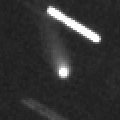
|
It has started fading before the perihelion passage. Now it is 17.0 mag (Aug. 11, Thomas Lehmann). Fading slowly. It will be fainter than 18 mag in November. In the Northern Hemisphere, it will never be observable after this. It locates somewhat low in the Southern Hemisphere.
Date(TT) R.A. (2000) Decl. Delta r Elong. m1 Best Time(A, h)
Aug. 31 9 39.85 -64 36.1 2.901 2.798 74 17.1 4:56 (330, 31)
Sept. 7 10 16.89 -64 50.7 2.963 2.810 71 17.2 4:47 (331, 29)
|

|
It will brighten up to 14 mag in 2025 spring. Now it is 17.7 mag (Aug. 24, ATLAS Chile). It stays 17 mag for a while. It locates somewhat low in the Northern Hemisphere. In the Southern Hemisphere, it stays observable in good condition.
Date(TT) R.A. (2000) Decl. Delta r Elong. m1 Best Time(A, h)
Aug. 31 0 22.82 -23 4.8 1.675 2.604 150 17.4 1:46 (180, 78)
Sept. 7 0 18.86 -24 39.8 1.613 2.557 154 17.2 1:15 (180, 79)
|
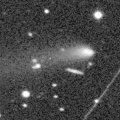
|
It brightened up to 14 mag in early 2023 and 2023 autumn. Now it is 17.1 mag (Aug. 14, A. Diepvens). Fading slowly. It will be fainter than 18 mag in October. It stays observable in good condition.
Date(TT) R.A. (2000) Decl. Delta r Elong. m1 Best Time(A, h)
Aug. 31 20 54.05 20 50.9 4.466 5.289 141 17.2 22:13 (180, 34)
Sept. 7 20 45.89 20 6.0 4.551 5.335 137 17.3 21:38 (180, 35)
|

|
Now it is 16.1 mag (June 5, Toshiyuki Takahashi). It stays 18 mag for a while. It will be getting lower gradually after this, and it will be unobservable in November in the Southern Hemisphere, or in December in the Northern Hemisphere.
Date(TT) R.A. (2000) Decl. Delta r Elong. m1 Best Time(A, h)
Aug. 31 15 40.46 -5 38.9 2.932 2.875 76 17.3 19:04 (129, 49)
Sept. 7 15 48.50 -6 19.3 3.020 2.878 72 17.4 19:09 (122, 46)
|

|
Now it is 17.9 mag (Aug. 24, ATLAS Chile). It stays 17 mag for a while. It stays observable in good condition.
Date(TT) R.A. (2000) Decl. Delta r Elong. m1 Best Time(A, h)
Aug. 31 22 57.15 -6 18.7 1.242 2.249 174 17.5 0:21 (180, 61)
Sept. 7 22 52.60 -6 35.6 1.216 2.224 177 17.4 23:44 (180, 61)
|

|
Now it is 17.0 mag (Aug. 15, ATLAS Chile). It stays 17 mag for a while. It will be unobservable soon in the Northern Hemisphere, or in November in the Southern Hemisphere. But it will be observable again in December.
Date(TT) R.A. (2000) Decl. Delta r Elong. m1 Best Time(A, h)
Aug. 31 15 8.77 -30 27.2 3.994 3.872 75 17.4 19:04 ( 87, 57)
Sept. 7 15 6.16 -29 57.3 4.097 3.842 68 17.4 19:09 ( 83, 50)
|

|
Now it is 17.5 mag (Sept. 1, ATLAS-HKO, Haleakala). Brightening slowly. It stays observable in good condition.
Date(TT) R.A. (2000) Decl. Delta r Elong. m1 Best Time(A, h)
Aug. 31 2 22.82 21 47.0 2.757 3.339 116 17.6 3:46 (180, 33)
Sept. 7 2 23.61 21 54.2 2.647 3.311 123 17.4 3:19 (180, 33)
|

|
Now it is 17.9 mag (Aug. 7, ATLAS-HKO, Haleakala). Fading slowly. It will be fainter than 18 mag in November. In the Northern Hemisphere, it stays observable in good condition. It locates somewhat low in the Southern Hemisphere.
Date(TT) R.A. (2000) Decl. Delta r Elong. m1 Best Time(A, h)
Aug. 31 2 47.61 24 22.4 1.737 2.297 110 17.5 4:11 (180, 31)
Sept. 7 2 49.39 26 16.1 1.670 2.302 116 17.5 3:45 (180, 29)
|

|
It stays 18 mag for a while. In the Northern Hemisphere, it stays observable in good condition. In the Southern Hemisphere, it is not observable now, but it will appear in October.
Date(TT) R.A. (2000) Decl. Delta r Elong. m1 Best Time(A, h)
Aug. 31 7 47.67 36 25.1 2.706 2.156 47 17.5 4:56 (226, -3)
Sept. 7 8 4.33 36 0.2 2.679 2.184 50 17.5 4:47 (226, -2)
|
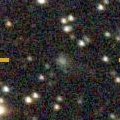
|
Now it is 17.6 mag (Apr. 11, Mt. Lemmon Survey). It stays 18 mag for a while. In the Northern Hemisphere, it stays observable in good condition. It stays extremely low in the Southern Hemisphere.
Date(TT) R.A. (2000) Decl. Delta r Elong. m1 Best Time(A, h)
Aug. 31 7 11.63 38 43.6 7.400 6.870 54 17.6 4:56 (220, 1)
Sept. 7 7 16.78 38 47.6 7.322 6.881 60 17.6 4:47 (218, 2)
|

|
Now it is 17.4 mag (Aug. 24, ATLAS Chile). It stays 18 mag for a while. It will be unobservable in December. It is expected to brighten up to 13 mag in 2026, and it will be observable in excellent condition in the Northern Hemisphere. In the Southern Hemisphere, it locates very low at the high light.
Date(TT) R.A. (2000) Decl. Delta r Elong. m1 Best Time(A, h)
Aug. 31 18 25.54 -39 2.0 7.129 7.630 116 17.6 19:46 ( 0, 86)
Sept. 7 18 23.80 -38 28.9 7.190 7.587 109 17.6 19:17 ( 0, 87)
|
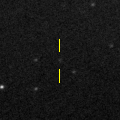
|
Now it is 19.0 mag (Aug. 11, W. Hasubick). It stays 17 mag for a while. It stays observable in good condition.
Date(TT) R.A. (2000) Decl. Delta r Elong. m1 Best Time(A, h)
Aug. 31 4 12.99 -4 47.5 3.759 4.006 96 17.7 4:56 (199, 58)
Sept. 7 4 16.31 -5 43.5 3.666 4.002 102 17.6 4:47 (192, 60)
|

|
Now it is 17.3 mag (Aug. 24, ATLAS Chile). It will fade out rapidly after this. It will be fainter than 18 mag soon. It stays observable in good condition.
Date(TT) R.A. (2000) Decl. Delta r Elong. m1 Best Time(A, h)
Aug. 31 21 15.18 -13 41.1 1.254 2.226 159 17.7 22:35 (180, 69)
Sept. 7 21 12.30 -14 38.0 1.330 2.267 151 17.9 22:05 (180, 70)
|
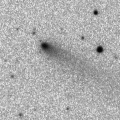
|
Now it is 18.5 mag (Aug. 11, W. Hasubick). It stays 18 mag for a while. It stays observable in good condition.
Date(TT) R.A. (2000) Decl. Delta r Elong. m1 Best Time(A, h)
Aug. 31 3 38.36 16 51.6 4.088 4.401 101 17.8 4:56 (182, 38)
Sept. 7 3 39.27 16 57.5 3.998 4.414 107 17.8 4:35 (180, 38)
|
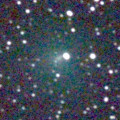
|
First return of a new periodic comet which was discovered in 2011, half a year after the perihelion passage. It brightened very rapidly up to 10.7 mag in spring (Apr. 28, Marco Goiato). Now it is 17.8 mag (July 26, ATLAS Chile). Fading rapidly. It locates somewhat low in the Northern Hemisphere. In the Southern Hemisphere, it stays observable in good condition.
Date(TT) R.A. (2000) Decl. Delta r Elong. m1 Best Time(A, h)
Aug. 31 16 24.67 -26 46.4 1.652 1.951 91 17.8 19:04 (111, 71)
Sept. 7 16 41.63 -26 21.2 1.780 2.013 87 18.3 19:09 (107, 68)
|
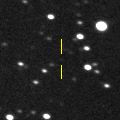
|
Brightening gradually. It will be unobservable in December. It will brighten up to 14.5 mag in 2025 spring. But the condition is bad.
Date(TT) R.A. (2000) Decl. Delta r Elong. m1 Best Time(A, h)
Aug. 31 15 44.89 -13 38.6 2.417 2.442 79 18.0 19:04 (121, 56)
Sept. 7 15 53.18 -14 40.1 2.474 2.415 74 17.9 19:09 (113, 52)
|

|
First return of a new periodic comet which brightened up to 15 mag in 2010. Now it is 18.8 mag (Aug. 13, John Maikner). It stays 18 mag for a while. In the Northern Hemisphere, it stays observable in good condition. It stays extremely low in the Southern Hemisphere.
Date(TT) R.A. (2000) Decl. Delta r Elong. m1 Best Time(A, h)
Aug. 31 6 53.13 31 25.1 2.185 1.836 56 18.0 4:56 (221, 9)
Sept. 7 7 12.34 31 26.9 2.153 1.856 59 17.9 4:47 (222, 9)
|

|
Now it is 17.4 mag (Aug. 3, ATLAS South Africa). It stays 18 mag for a while. It stays extremely low in the Northern Hemisphere. But it will become high in spring. In the Southern Hemisphere, it will be getting lower gradually.
Date(TT) R.A. (2000) Decl. Delta r Elong. m1 Best Time(A, h)
Aug. 31 15 46.68 -33 56.4 4.492 4.507 84 17.9 19:04 ( 84, 66)
Sept. 7 15 52.80 -33 37.2 4.581 4.498 78 17.9 19:09 ( 82, 61)
|
|
![]()
 C/2019 L3 ( ATLAS )
C/2019 L3 ( ATLAS ) C/2023 Q1 ( PanSTARRS )
C/2023 Q1 ( PanSTARRS ) C/2019 U5 ( PanSTARRS )
C/2019 U5 ( PanSTARRS ) C/2023 TD22 ( Lemmon )
C/2023 TD22 ( Lemmon ) 299P/Catalina-PanSTARRS
299P/Catalina-PanSTARRS 472P/2023 RL75 ( NEAT-LINEAR )
472P/2023 RL75 ( NEAT-LINEAR ) P/2024 N5 ( Siding Spring )
P/2024 N5 ( Siding Spring ) C/2024 M1 ( ATLAS )
C/2024 M1 ( ATLAS ) C/2020 K1 ( PanSTARRS )
C/2020 K1 ( PanSTARRS ) C/2022 R6 ( PanSTARRS )
C/2022 R6 ( PanSTARRS ) C/2024 B1 ( Lemmon )
C/2024 B1 ( Lemmon ) 89P/Russell 2
89P/Russell 2 P/2023 S1
P/2023 S1 C/2023 F3 ( ATLAS )
C/2023 F3 ( ATLAS ) 192P/Shoemaker-Levy 1
192P/Shoemaker-Levy 1 C/2024 A1 ( ATLAS )
C/2024 A1 ( ATLAS ) C/2019 E3 ( ATLAS )
C/2019 E3 ( ATLAS ) C/2022 U1 ( Leonard )
C/2022 U1 ( Leonard ) C/2019 T4 ( ATLAS )
C/2019 T4 ( ATLAS ) 253P/PanSTARRS
253P/PanSTARRS C/2022 U3 ( Bok )
C/2022 U3 ( Bok ) 328P/LONEOS-Tucker
328P/LONEOS-Tucker C/2023 R1 ( PanSTARRS )
C/2023 R1 ( PanSTARRS ) 302P/Lemmon-PanSTARRS
302P/Lemmon-PanSTARRS C/2022 S4 ( Lemmon )
C/2022 S4 ( Lemmon ) 49P/Arend-Rigaux
49P/Arend-Rigaux C/2021 X1 ( Maury-Attard )
C/2021 X1 ( Maury-Attard ) 362P/(457175) 2008 GO98
362P/(457175) 2008 GO98 190P/Mueller
190P/Mueller C/2024 L5 ( ATLAS )
C/2024 L5 ( ATLAS ) 43P/Wolf-Harrington
43P/Wolf-Harrington 338P/McNaught
338P/McNaught 50P/Arend
50P/Arend C/2021 S4 ( Tsuchinshan )
C/2021 S4 ( Tsuchinshan ) C/2024 J3 ( ATLAS )
C/2024 J3 ( ATLAS ) 242P/Spahr
242P/Spahr 125P/Spacewatch
125P/Spacewatch 117P/Helin-Roman-Alu 1
117P/Helin-Roman-Alu 1 479P/2023 WM26 ( Elenin )
479P/2023 WM26 ( Elenin ) 48P/Johnson
48P/Johnson P/2024 O3 ( LINEAR )
P/2024 O3 ( LINEAR ) C/2023 H1 ( PanSTARRS )
C/2023 H1 ( PanSTARRS )![]()


























































